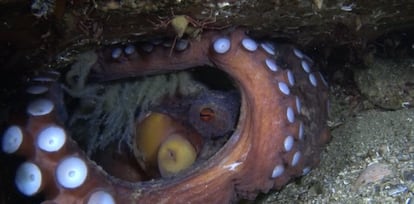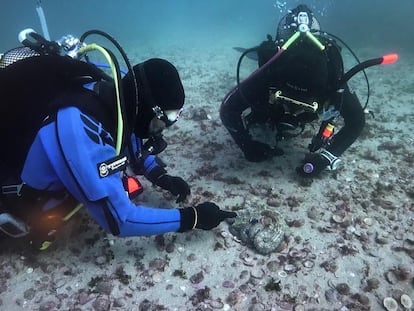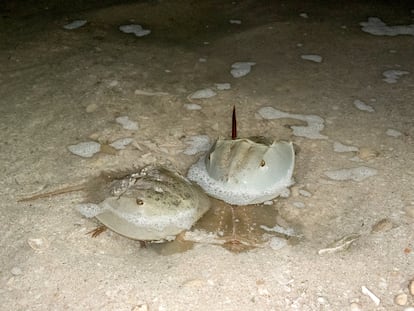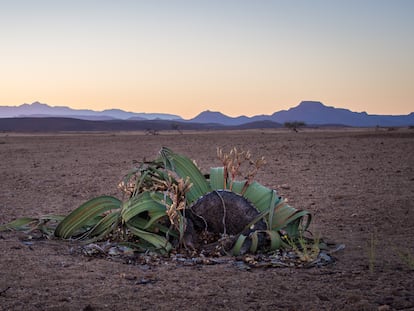Loving to death: The fate of a mother octopus
Researchers have caught on video, for the first time, the self-sacrificing sex life and reproductive cycle of the female cephalopod in northwest Spain

This story begins like so many others: with a sex scene. Or, as marine biologist Álvaro Roura put it, with “indifferent intercourse.” Roura, who has dedicated his life to the study of these clever creatures on the coast of Vigo (northwest Spain) and who worked for years at Spain’s National Research Council (CSIC), explained that “when octopuses have sex, there’s not a twitch, not even a change in color.” In this copulation, which can take up to an hour, there are no apparent signs of enjoyment. There is, however, a clear, selfless mission that the female octopus must complete during it, “from the moment she only weighs 180 grams” until she is “an eight-kilo adult.” Her goal is to get her tentacles on a good amount of spermatophores – sperm capsules – from different males, which then “explode like firecrackers” inside her when in contact with water.
The female octopus’ life will go on like this for a year. Storing the fertilizing material in spermatheca and feeding it, inside her oviductal gland, until she finds an adequate place to establish her single-parent family and is ready to spawn for the first and last time in her life. Motherhood will be terminal for her. She will no longer eat and will end up dying, consumed, exhausted, approximately five months (between June and October) after having set up her shelter, after all her children have been born.
For the first time ever, researchers captured in a video the intercourse and the entire reproduction process of the Octopus vulgaris in the wild. The images, recorded in the Vigo estuary, are the result of “eight years of immersion, summarized in five minutes,” according to Roura. He was in charge of the scientific part of the project, but also worked with scuba diver Jade Irisarri and with the multi-award-winning underwater documentary filmmaker, diver and chemist José Irisarri.
Female octopuses have a very short lifespan of less than two years. This way of living and dying after giving birth is the “strategy” of their species – as well as others “like salmon or lamprey,” which are known as semelparous and only have one reproductive cycle before death. Each season, the sea is populated by a new generation of octopuses while the previous one deteriorates and dies – unlike species like the shortfin mako shark, which according to the biologist takes almost as much time as humans to reach maturity (18 to 20 years) and breeds three times in life.
But while the female mako bears 15 offspring, the female octopus can lay between 300,000 and half a million eggs, which hang from the ceiling of her cave on strips of white lace. The length of these garlands varies, depending on the height of the den; each one can hold between 800 and 2,000 eggs. The mother settles below and, until she dies, she will spend her time caressing, blowing water and oxygenating the clusters, always ready to protect her children from any predators that might lurk behind the wall of stones and shells that she built at the entrance.

“This epic ending has worked for them for more than 200 million years; there must be a reason behind it,” Roura said. Their sophisticated reproductive system not only allows for the sperm of the male to be stored until the right moment, but it also fertilizes individually each egg, which, before being expelled and placed in the garlands (also one by one, in a phase that lasts one month) are protected with a hard and clear glass-like shell that works like “an epoxy resin,” the specialist explained, “and in fact it polymerizes in water, thanks to the mixture of two components known as A and B.”
The eggs take three months to hatch, and by the time the last larva is finally born, the mother has lost all her musculature. Meanwhile, in their new planktonic stage, the babies (which measure less than three millimeters) travel 200 kilometers offshore, carried away by the currents. They will return to the coast later, transformed into juvenile octopuses, already sporting 20 suckers on each arm. Soon after that, the females will follow the example of their mothers.
It is all written in their endocrine system; since the late 1970s, it is a known fact that their tragic end is determined by the optic gland, which is located in the brain, behind the eyes. The female octopuses that had it removed took motherhood much more lightly and survived. However, it was not until the last decade that a team of neurobiologists from the University of Chicago managed to describe, with genetic sequencing techniques, the molecular signals that are capable of controlling the phases of maternity and death of the females.
It does not matter if the mothers live free or in captivity. Their way of decorating their nests with lace curtains and their final sacrifice is repeated in the sea and in the tanks. Four years ago, in Vigo, two public organizations held their breath as their female octopuses prepared to complete their cycle of life. They were Carmiña, at the CSIC, and Lourditas, at the Spanish Institute of Oceanography (IEO). Carmiña, named by Roura, “laid her first eggs the day the pandemic was declared,” the doctor recalled. Lourditas had already done it a few months earlier, in 2019. The two matriarchs tirelessly cared for and protected their laboratory shelters as if they were underwater cavities. Then, after fulfilling their eternal mission, they let go and died.
Sign up for our weekly newsletter to get more English-language news coverage from EL PAÍS USA Edition
Tu suscripción se está usando en otro dispositivo
¿Quieres añadir otro usuario a tu suscripción?
Si continúas leyendo en este dispositivo, no se podrá leer en el otro.
FlechaTu suscripción se está usando en otro dispositivo y solo puedes acceder a EL PAÍS desde un dispositivo a la vez.
Si quieres compartir tu cuenta, cambia tu suscripción a la modalidad Premium, así podrás añadir otro usuario. Cada uno accederá con su propia cuenta de email, lo que os permitirá personalizar vuestra experiencia en EL PAÍS.
¿Tienes una suscripción de empresa? Accede aquí para contratar más cuentas.
En el caso de no saber quién está usando tu cuenta, te recomendamos cambiar tu contraseña aquí.
Si decides continuar compartiendo tu cuenta, este mensaje se mostrará en tu dispositivo y en el de la otra persona que está usando tu cuenta de forma indefinida, afectando a tu experiencia de lectura. Puedes consultar aquí los términos y condiciones de la suscripción digital.
More information
Archived In
Últimas noticias
Welcome to the post-religion era: The idea of Christianity as the absolute truth has become obsolete
‘I thought you would like it’: The risky sexual practice popularized by TV shows and TikTok
The digitalization of tourism: ‘They promise experiences and gave us the worst possible one’
Mexican peso defies uncertainty with forecasts of a new period of stability in 2026
Most viewed
- Sinaloa Cartel war is taking its toll on Los Chapitos
- Reinhard Genzel, Nobel laureate in physics: ‘One-minute videos will never give you the truth’
- Oona Chaplin: ‘I told James Cameron that I was living in a treehouse and starting a permaculture project with a friend’
- Why the price of coffee has skyrocketed: from Brazilian plantations to specialty coffee houses
- Silver prices are going crazy: This is what’s fueling the rally










































